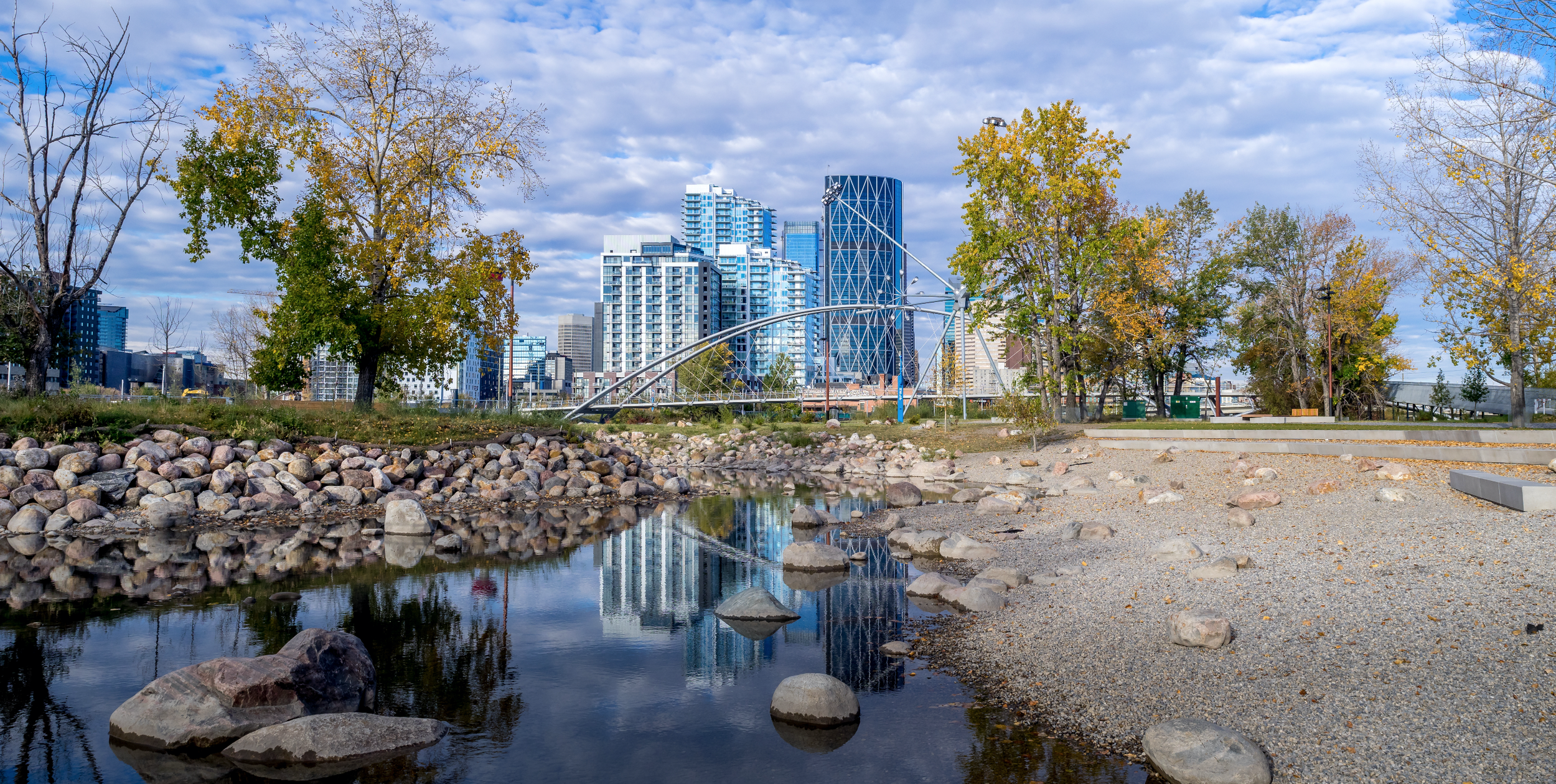5.0
Protecting Our Water
YYC Calgary International Airport covers a total land area of 20.82 km², has 22 stormwater management ponds, two of which are dedicated to the treatment and removal of glycol that cannot be collected for recycling. YYC owns and operates approximately:
250 active groundwater monitoring wells, used for monitoring water-quality and flow
100 km of stormwater pipes used for drainage
50 km of potable water distribution pipes
35 km of sanitary pipes on airport property, excluding the infrastructure in our buildings.

Applicable United Nations (UN) Sustainable Development Goals (SDGs)
By 2025, prevent and significantly reduce marine pollution of all kinds, in particular from land-based activities, including marine debris and nutrient pollution (14.1)
By 2020, sustainably manage and protect marine and coastal ecosystems to avoid significant adverse impacts, including by strengthening their resilience, and take action for their restoration in order to achieve healthy and productive oceans (14.2)
By 2030, achieve universal and equitable access to safe and affordable drinking water for all (6.1)
By 2030, improve water quality by reducing pollution, eliminating dumping and minimizing release of hazardous chemicals and materials, halving the proportion of untreated wastewater and substantially increasing recycling and safe reuse globally (6.3)
By 2030, substantially increase water-use efficiency across all sectors and ensure sustainable withdrawals and supply of freshwater to address water scarcity and substantially reduce the number of people suffering from water scarcity (6.4)
By 2030, implement integrated water resources management at all levels, including through transboundary cooperation as appropriate (6.5)
By 2020, protect and restore water-related ecosystems, including mountains, forests, wetlands, rivers, aquifers and lakes (6.6)
Support and strengthen the participation of local communities in improving water and sanitation management (6.b)
Due to their large land area, our airports are important features within our local watersheds. YYC Calgary International Airport is located in the Nose Creek Watershed and is serviced for potable water and wastewater by the City of Calgary. Springbank Airport is located in the Bow River watershed and is serviced by water deliveries and an on-site wastewater treatment facility.
YYC is taking an integrated approach to water management, recognizing the important connections between potable water use, wastewater, surface water and groundwater management in the environment, and addressing both water quality and flow/quantity.
5.1
Reduce Water Use
We know how valuable Calgary’s water supply is and the increasing demand a growing population puts on the Bow and Elbow rivers. As overall temperatures increase in Calgary and droughts become a more common occurrence, water conservation strategies and initiatives will become paramount. YYC has committed to a 30% reduction in water consumption over 2018 usage by 2050.
| 2050 Goals | 2026 Goal |
|---|---|
| Reduce potable water use by 30% over 2018 usage | Reduce potable water use to 370,213 m3 or lower by 2026 (10% reduction over 2018) |
Water reduction is included in YYC Corporate Sustainability KPI and is based on potable water usage. Water use at YYC is closely tied to passenger volumes. As of 2021, the short-term water conservation target was met, however this was largely because of decreases in passenger traffic due to the COVID-19 pandemic. The key goal for YYC moving forward will be to ensure potable water use does not exceed current annual volumes as passenger growth returns to pre-COVID-19 levels.
Our Water Use
Tactics
As the airport continues to see year-over-year passenger growth, so does the demand for clean fresh water. That’s why we are investigating several opportunities to reduce water usage.
-
There are many benefits to reducing water demand including utility cost savings, increased resilience to climate change impacts and energy savings. In 2022, the airport will be replacing all the faucet aerators and dish pit sprayers across the terminal which could result in a demand reduction of up to 10%. This year the airport will also be installing an intake aerator that will increase water supply efficiency. Other opportunities include water conservation programs, upgrading vehicle washing nozzles and replacing once-through cooling units in the industrial kitchens
-
Calgary is considered a semi-arid climate, but according to recent climate change projections, total annual precipitation is expected to increase. YYC is evaluating recommissioning our stormwater capture cisterns located in the International Terminal Building. In the future, rainwater recapture could be expanded to include stormwater ponds and sources of wastewater. The airport is also evaluating other opportunities for onsite water treatment and reuse
5.2
Promote Healthy Water Quality
We understand the impact that water quality has on people and the environment. Access to clean drinking water is a basic human right and is included in the UN Sustainable Development Goals. To help sustain aquatic life and wildlife in and around Calgary, we must maintain healthy water quality, for water bodies within our airports’ watersheds: Nose Creek (YYC), the Bow River (YBW), and the local groundwater systems.
Given the heavily impacted state of the Nose Creek watershed, we recognize the importance of multi-stakeholder collaboration to address widespread and cumulative impacts on water quality. A key part of this work is maintaining our role as a member of the Nose Creek Watershed Partnership which, through inter-municipal cooperation, works to protect and improve the local watershed. The airport also works closely with the City of Calgary to understand the complexities of Calgary stormwater systems and protect and enhance the water quality.
Airport Water Quality
For any urban area, there are a host of water quality issues and management objectives that can be prioritized. Our overall water quality objective is to meet or exceed whichever is more stringent of the Environmental Quality Guidelines for Alberta Surface Waters or the Canadian Council of Ministers of the Environment for all drainage water. We also work closely with the City of Calgary to ensure we meet their Stormwater Bylaw. The table below provides a summary of the key water quality indicators based on site-specific management priorities and current targets of relevance to YYC. Despite these priority parameters however, YYC routinely monitors water quality for over 60 individual parameters at all our stormwater ponds and drainage outfalls. A similar suite of parameters is also regularly sampled for at groundwater monitoring wells across our site both to understand interactions between surface and groundwater systems and better understand the hydrogeology of our site.
| Water Source | Water Quality Indicators and Targets |
|---|---|
| Stormwater Discharges North Retention Pond (NRP) Releases to Stormwater |
• TSS < 25 mg/L • Turbidity < 20 NTU • pH = 6.5 to 9.0 • COD < 100 mg/L • BOD < 20 mg/L • Sulphide < 1 mg/L • Oil & Grease < 10 mg/L • Total glycols < 100 mg/L • Acute trout toxicity test pass |
| Other Sanitary Discharges |
• No exceedances of Schedule C of the City of Calgary • BOD < 2,400 mg/L • TSS < 800 mg/L • Oil & Grease < 500 mg/L • Sulphide < 1 mg/L |
For Canadian airports, a major focus of water quality management is keeping concentrations of ethylene glycol, the key ingredient in aircraft anti-icing and de-icing fluid, to a minimum. YYC aims to achieve a goal of never discharging concentrations greater than 100 mg/L and aims to keep release concentrations lower than 100 mg/L.
Since 2018, it has also become evident that the interaction of groundwater and surface water systems at YYC contributes to potential water quality risks. Shallow groundwater tends to be naturally high in dissolved solids, in particular minerals with high sulphur content. This can result in odour and water colour issues. A key part of our strategy around water quality management is to minimize the interaction or infiltration of groundwater into surface water management infrastructure. Addressing this is an important aspect of reducing cumulative effects to watershed water quality.
Groundwater quality in relation to contaminated sites is also a critical component of overall environmental water quality management that can support reducing the cumulative effect of human development on watershed, particularly for emerging contaminants like PFAS. This is specifically addressed in the sustainable land development practices of this strategy; however, it is an essential element of overall water quality protection. All our goals in materials and resource management also play a critical role in reducing the sources of chemicals at YYC that, if released, can impact water quality.
Tactics
-
YYC has 22 stormwater management ponds and approximately 100 km of stormwater pipes used for drainage. YBW also has a stormwater management pond and wastewater lagoon. Every year the airport undertakes multiple projects to improve airport infrastructure, enhancing stormwater management assets to improve water quality, flood management and incorporate climate change
-
YYC recently moved to a centralized de-icing operation, which increased the ability to recycle the de-icing fluid in our glycol recycling facility. YYC will be conducting a study to investigate the source and treatment of fugitive glycol
-
The Calgary Airport Authority has an extensive water quantity and quality monitoring program that includes regular monitoring of surface water outfalls, stormwater ponds and groundwater wells. YYC is committed to the continued improvement of monitoring, data analysis and tracking
Focus Areas









